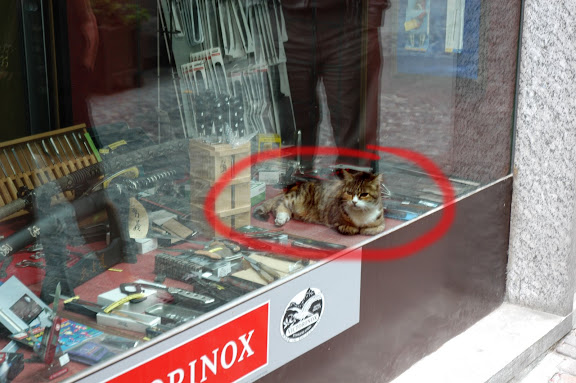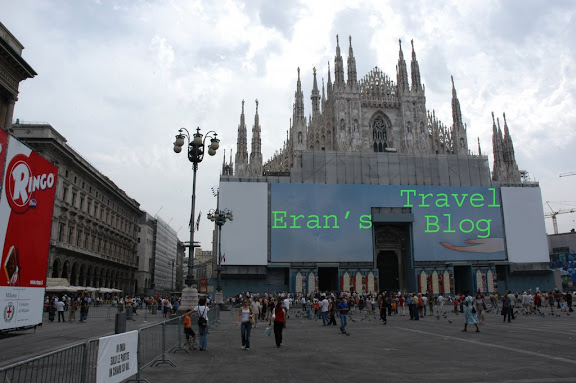June 16-18 2006
Day 1 - Ivrea
Ivrea sits on a river in north western Italy, roughly where the alps start gaining altitude in their rush towards Switzerland. Had you opened up google maps a couple of months ago and asked for a view of Europe, you'd have discovered a very interesting fact. The only area that had roads was around Torino. Nowadays, a whole month later, there are roads all over Europe. There are two commonly held theories about this:
- Europe is coming out of the middle ages very very quickly. After a quick pilot of roads in northern Italy, they decided to go and buy the premium package, complete with highways, traffic jams and everything else you need to compete in this modern world.
- The other theory is that google originally only had maps for people going to the olympics. Where else would Americans who use google go in those far away lands where strange people speak even stranger languages and don't understand proper English? Apparently the business case for mapping the rest of Europe finally went through, or else some engineer in google spent his or her 20% work-on-your-own-project-idea time to draw roads across the rest of Europe and voila! Instant maps.
Of the three cities we managed to see, this one had the best atmosphere, possibly because it's less of a tourist destination. A nice promenade with some restaurants and stores was mostly filled with locals on Thursday night, though on Friday it was suspiciosly empty and we couldn't figure out if everyone's at home or if they all went out to Torino.
Looking at one of the stores, we noticed this guard-cat keeping an eye on the scary knife store.
 Day 2 - Torino
Day 2 - TorinoTorino lies south of Ivrea, about a 2 hours train ride away. When we exited the train into Torino's center, we found out it was international Vespa day there.
There were Vespas of all sizes and colors, including this RGB set. By mixing these three Vespas you can get a Vespa of any other color:
Torino is famous for its cloisters, the covered area of stores that the king built so that he can walk around without getting rained on. The arches of the cloisters influence the whole city's architecture and I had fun catching different arches throughout.
There's more in the web album for this trip linked at the bottom of this entry.
Day 3 - Milano
On day 3, we took the train to Milano. I decided to only carry one of the guidebooks we had with us and so selected the big one focusing on northern Italy only. Little did I know what I was getting myself into.
On the train, I opened up the guide and went through the Milano section. The guide I usually prefer is the Lonely Planet and I know which section to look for and what to read. I also like the way they make the place you're going to sound colorful and exciting. The guide we actually had was a little different. It talked about the main square in Milano and the different buildings around it. From it, we learned about the Duomo, one of the largest churches in Europe.
 (unfortunately it is being restored, hence the big advertisement at the front)
(unfortunately it is being restored, hence the big advertisement at the front)Since Milano was where the Roman Emperor finally converted to Catholicism, the city was a center for Christianity for a long time. The Duomo is an impressive building, decorated with statues and gargoyles (I'm sure there's a scientific name) all around, while inside it's a huge open space with pictures hanging from the ceiling, colored-glass windows and benches for the congregation.
A pretty big area for lighting candles is also provided.
After describing the church and all its art pieces, the guidebook goes on to talk about the outside stairs (lots of them) that let you climb up to the top of the church and walk along an extremely well statued roof to see the city from high up.
 Then the guidebook went on to talk about all the building around that main square in Milano. For the museum and the old palace, it went into details about each room and which art pieces can be found there, including a floor map. Then it extended to the rest of Milano, talking about other buildings, statues, pictures, floor plans for museums, etc.
Then the guidebook went on to talk about all the building around that main square in Milano. For the museum and the old palace, it went into details about each room and which art pieces can be found there, including a floor map. Then it extended to the rest of Milano, talking about other buildings, statues, pictures, floor plans for museums, etc.Then it talked about art some more. Then it went on to talk about art in the next town.
I was very disappointed. No color, no excitement, no pizzazz. I couldn't figure out why Milano was so boring the book had nothing else to talk about. In fact, it turns out all of Northern Italy is full of art and nothing else. Closing the book, I looked at the cover again. It was the, yes, you guessed it, guidebook for fine art of Northern Italy. :( The fun stuff stayed at the hotel, waiting for us to return.
Lesson of the day: READ the guide before going there. Not because of where you're going, just to make sure you've got the right guide with you.
We walked around Milano for a few hours. It's a beautiful city with lots of art to see :)
On the way, we came to an antique market that had various pieces for sale. One of the stalls had a set of interesting artifacts, including a book in a language I've not seen before. The african-NOT-american (african-italian? african-milanoan?) quickly came over to explain that it's written in Amharic, the language of Ethiopia. I asked if it's from right-to-left and he said yes, it's like Hebrew. And I said yes, I know Hebrew. And he switched to Hebrew and said - are you from Israel? And we had a great old time talking about how he was part of the 10 lost tribes, specifically the one that ended up in Ethiopia; How he came to Israel for a few years; How eventually he moved to Italy. Not really African-anything after all :)
You can see the some more pictures from all 3 days at http://picasaweb.google.com/eran.davidov/ItalyJune06
Eran
Technorati Tags: Ivrea, Torino, Milano, Vespa, Duomo, Eran Davidov, Travel Blogs
No comments:
Post a Comment